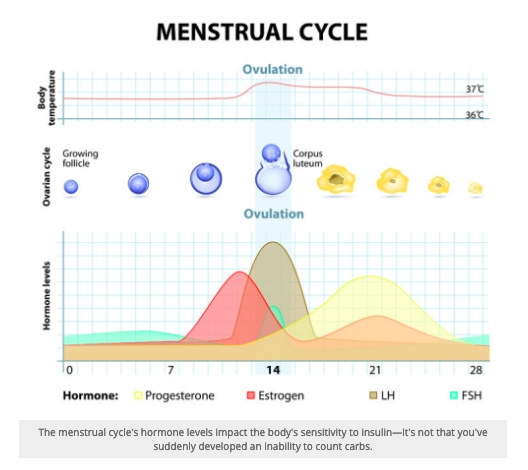As someone with type 1 diabetes, and coaching many with diabetes, we have to consider over 50 things that are non-food related that can affect our blood sugar control, and one of the most common moving variables include the female cycle.
In fact, I have to change my daily basal weekly, if not more, to coincide with my cycle and insulin sensitivity. Along with this tweaking, I have been collecting data and savvy tips in a notebook on this topic and have organized the insights below.
Wellness for a female is different and is achieved differently than for a male. There needs to much a bigger component of emotional health and support, which is why it’s important to understand our moving hormones.
OUR PERIOD
The benefit of being a female (among many!) is we have a period. Wait, how is that a benefit? Well, our cycle is termed as a 5th vital sign per the American College of Obstetricians and Gynecologists (ACOG) Committee Opinion and this vital sign offers insight into our health, each month.
First and foremost, when assessing your period, understand our body will always choose survival over making babies. In fact, the period you have this month reflects your life 2-3 months ago. As well, if you are taking savvy hormone balancing supplements like maca, chaste tree, vitex, evening primrose oil, to name a few, give it 3-4 months to take effect.
Balanced/Balancing Hormones Involves the Combo of:
- Daily bowel movements. If you don’t poop every day – you can’t remove the digested estrogen out of your system. Gut health is super important.
- Modulating toxins in our life. Most environmental toxins will come from the practices women take within hours of waking up – deodorant, makeup, toiletries.
- Sleep. If you are not sleeping 7 hours a night, you are not going to have balanced hormones. Research even shows that the liver can’t detox with sleep deprivation and liver needs to be optimal to metabolize our hormones as well.
- Diet. Eat regular and balanced meals, emphasizing the importance to eat healthy fats. Avocado, olive oil, and organic animal fat are great sources, to name a few. The research on broccoli is so strong for detoxing estrogen and this is crucial for hormone balance. If a female is not having a bowel movement daily, the estrogen is sitting in the intestines and can be reabsorbed. We want it to move along as it should daily, and if this is not happening, consider tweaking the diet to include more vegetable fiber, remove grains in the diet and add a magnesium supplement to get things moving. Overall, lots of leafy green vegetables are key to a nourished body and healthy, fertile hormones.
- Blood sugar stability. This is one of the most crucial things for hormone balance. Do the best you can to reduce blood sugar swings and variability. If blood sugars are too high they can structurally change the ovaries.
- Movement. Most of our hormones won’t work unless we are moving. This is esp true w/ inactive thyroid to active thyroid.
- Happiness: Plan a girls night and go have some fun. Or find a good book. Whatever helps you live a little and un(wine)d.
- Sex. Yes, sex, intimacy and orgasm can help naturally balance hormones.
MONTHLY CYCLE:
While PMS is not normal it is natural to feel a shift in energy throughout the month, and that’s why it’s important to vary the amount and type of exercises you are doing and cycling your food/carbs throughout the month.
Week 1 (on period): MENSTRUAL
Day 1-10 females are most like males. Progesterone and estrogen are the lowest, and the first half of the cycle is called the follicular phase.
Insulin – many women may experience high blood sugars on the first day of their cycle, but it levels out the remainder of the days of bleeding. Personally, (bc I am sure you want to know), I am more insulin resistant on the first and last day of my cycle/bleeding, so therefore I may have a basal of let’s say 10 units on Day 1, drop down to 9 units, and then on the 6th day of bleeding I go back to 10 units.
Diet – Aim to eat higher fat and protein-rich meals, which means to ease up on carbs (fruit, legumes, grains, starchy veg), but do not restrict as much as you did before you started to bleed.
Protein helps to replenish lost iron. If a period is heavy – eat iron-rich foods with a focus on vitamin C. A citrus, spinach salad with some steak? Other good foods to source: seafood or seaweed, and low carb vegetables.
Exercise – slow movement pilates or yoga, stretching, walking or light hiking. A few days after the onset of your period you may feel energized and ready to pick back up your exercise routine. Movement this week can be variable from girl to girl, and from month to month. Listen to your body and what it needs.
Agenda – This is a good week to ground yourself, relax more physically and construct or address personal goals. Pull out a journal and reap the benefits of writing out your thoughts.
Seed cycling: 1T of pumpkin seeds and 1T of flax meal per day.
Week 2: FOLLICULAR
Diet – highest carb week, lowest calorie.
Persist including protein and fat in each meal, but bring down the total fat, and increase carbs. Typically, meals will be smaller than the 2 weeks before your period/bleeding. Females are most insulin sensitive around this time of their cycle and they can tolerate more carbs without blood sugar spikes. Since the onset of your period, your estrogen will gradually rise until ovulation (which starts at the end of this week). Keep in mind estrogen has an inverse relationship to appetite. When estrogen is highest, you may notice less hunger.
Exercise – a great time to do HIIT training, challenging and longer workouts.
Agenda – it’s common to be restless and able to tackle projects and goals, including batch cooking for the week ahead when willpower is less. Right before ovulation, you may notice you feel your best, sexiest and most social. Make the most of it.
Seed cycling: 1T of pumpkin seeds and 1T of flax meal per day.
Week 3: OVULATORY
Insulin – blood sugars can seem less seamless (to put it nicely). For 2-3 days blood sugars will run higher, and I view this as a mini period. What I do to manage my blood sugars and insulin here, I do more aggressively, and for more days, prior to bleeding.
Diet – Wind down the carbs, and begin increasing fat and fiber. You may notice some cravings for chocolate as well. Increase magnesium-rich foods, including cocoa. Five days after ovulation, you might find benefit and emotional/energy relief in eating ~30 grams of carbs at dinner (assuming you are eating a lower carb diet; less than 100 grams). This bolus of carbs (like half of a sweet potato) can support serotonin levels and improve sleep, sense of calm.
It’s not uncommon to have constipation post ovulation. Find use of chia seeds, and high fiber veggies. Focus on hydration aggressively until end of week 4.
Agenda – Ovulation is a great time to enjoy raw foods, raw salads, high-quality protein, and foods high in zinc. During ovulation, you may notice slight cramps. Your body is preparing to release 1 of 500 eggs (which is a fraction of the eggs you were born with). Ovulation is on average 10-16 days before a period. After Ovulation, this is when progesterone and estrogen increase and progesterone release a lot of sodium and holds onto a lot of water. This can lead to bloating. Your body temperature may be a degree higher as well. You want to salt (NOT table salt, sea salt please) your food here. Listen to your body needs.
The second half of a female cycle is called the Luteal phase.
Seed cycling: 1T of sesame seeds and 1T of sunflower seeds per day. I use tahini and sunbutter often during this half of the month.
Week 4: (right before period) LUTEAL
Insulin: the 7-10 days leading up to your period, insulin demands will be the highest and trickiest. This is where I take notes on what basal totals I am taking days leading up to my period and what cravings I had and how I treated them. I personally take these notes in my calendar on my phone – and happen to miss a few months, but I always have some notes to fall back on. It’s also common to see a need to increase basal insulin the most the day before your period (thanks progesterone!). If on an insulin pump, it can be a great idea to have a separate basal pattern to switch to for these days.
Diet – Lowest carb. Eat more cruciferous vegetables, more root vegetables. Limit booze AND caffeine (even though we may be craving them more).
Start increasing fats and lowering carbs or being more strategic with carbs (aka plan out your meals). Roasted foods are really good right now as they bring out the sweetness of vegetables. Note, however, this is a good time to eat more food period. If you limit food to amounts from prior weeks, you will indeed crave more sweets, as your body merely needs more calories. Many females deny themselves of this and end up with larger cravings. Days leading up to a female’s period, serotonin production is less. Eat high tryptophan foods (turkey, bananas, buckwheat, oily fish, flaxseed).
Studies have shown women who have a high intake of oily-fish (omega 3 fatty acids) including sardines, salmon, and mackerel, tend to have milder PMS. EFAs are also hormone regulators.
Leafy greens right before your period is helpful in calming your nervous system (due to calcium, magnesium and potassium). Even consider a green powder here, such as those sold by Organifi.
Overall understand your desires for food when it’s this time of the month. Just understanding what is going on with your body can help resolve overeating or poorer food choices. “This too shall pass.”
Exercise – step back and understand what your body needs. It could be stretching or it could be a long hard workout. This week is often a wild card.
Agenda – This is the best week to have pre-planned meals as your energy and interest in making meals will be low.
Supplements – Magnesium supplementation is important for cravings, energy, mood and blood sugar control, especially 7 days before the period. Additionally, fish oil, B vitamins, and tryptophan are recommended to help with PMS and can be used starting with ovulation (if not all month).
Seed cycling: 1T of sesame seeds and 1T of sunflower seeds per day. I use tahini and sunbutter often during this half of the month.
Related Reading:




really helpful information. it’s an area where I find endocrinologists don’t have a lot of specific advice and gynecologists aren’t educated in diabetes specifics. so getting holistic answers are difficult. thanks for the comprehensive detail.
Hi Jessica – thank you for the feedback, and indeed, I already see the need to do a follow-up post!